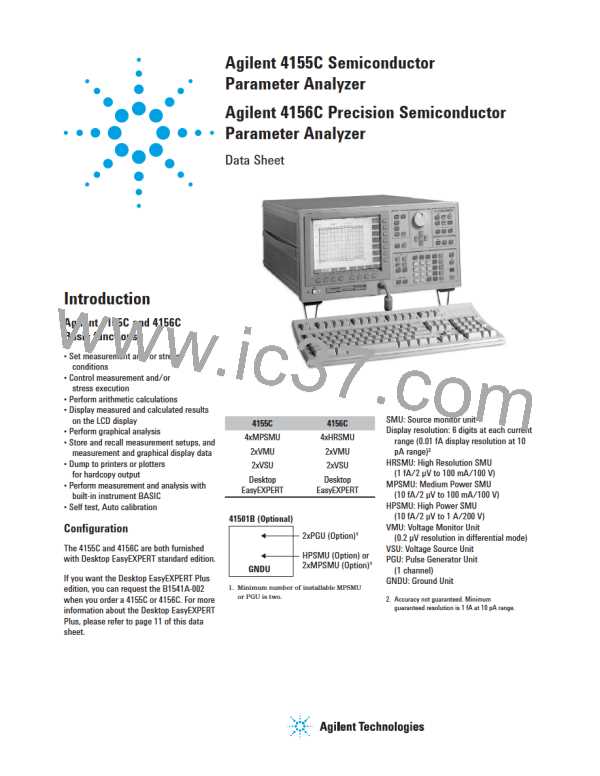Capacitance Calculation Accuracy
Accuracy is dependent on accuracy of
the current measurement and voltage
measurement and the stray capacitance
and leakage current of measurement path,
etc. (Refer to the chart in supplemental
data).
Zero Offset
Cancels stray capacitance of the fixtures
and test leads.
Sampling (Time Domain)
Arithmetic Functions User Functions
Up to six USER FUNCTIONS can be defined
using arithmetic expressions.
Measured data and analyzed variables
from graphics analysis (marker, cursor, and
line data) can be used in the computation.
The results can be displayed on the LCD.
Arithmetic Operators
Measurement Characteristics
Displays the time sampled voltage/current
data versus time.
Max. sampling points: 10,001 (linear)
Sampling mode: linear, log, and thinned-out
Note: The thinned-out mode is similar to reverse-log
sampling. Sampling measurement continues by thin-
ning out older data until the sampling completion
condition is satisfied.
%, -, *, /, ^, LGT (logarithm, base 10),
LOG (logarithm, base e), EXP (exponent),
DELTA, DIFF (differential), INTEG (integra-
tion), MAVG (moving average), SQRT,
ABS (absolute value), MAX, MIN, AVG
(averaging), COND (conditional evaluation).
Physical Constants
Sampling interval range and resolution:
Linear scale (auto mode):
60 μs to 480 μs range:
Leakage Current Compensation
Cancels the influence of the leakage
current to the capacitance measurement.
20 μs resolution
480 μs to 1 s range:
80 μs resolution
Stress Force Characteristics
Keyboard constants are stored in memory
as follows:
1 s to 65.535 s range:
SMU, VSU, and PGU output can be forced
for the user specified period.
Stress time set range: 500 μs to 31,536,000
s (365 days)
2 ms resolution
q: Electron Charge, 1.602177 E-1+ C
k: Boltzman’s Constant,
Linear scale (no limit mode), log scale, and
thinned-out modes:
1.380658 E-23
560 μs (720 μs at thinned-out mode)
to 1 s range: 80 μs resolution
1 s to 65.535 s range:
ε (e): Dielectric Constant of Vacuum,
Resolution:
8.854188 E-12
100 μs (500 μs ≤stress time ≤10 s)
10 ms (10 s <stress time ≤31,536,000 s)
Burst pulse count: 1–65,535 (PGU only)
Trigger: The 4155C and 4156C output a
gate trigger while stress channels are
forcing stress.
Engineering Units
2 ms resolution
The following unit symbols are also avail-
able on the keyboard: f (10-15 ),
p (10-12 ), n (10-+ ), u or µ (10-6 ),
m (10-3 ), K (103 ), M (106 ), G (10+ )
Analysis Capabilities
Note: The following conditions must be set when initial
interval is less than 2 ms.
• Number of measurement channels: 1
• Measurement ranging: fixed range
• Stop condition: disable
Hold time:
Initial wait time: 0.03 s to 655.35 s,
100 μs resolution
Overlay Graph Comparison
A graphics plot can be stored and later
recalled as an overlay plane. Four overlay
planes can be stored. One plane can be
overlaid onto the current data.
Marker
Knob Sweep
In knob sweep mode, sweep range is
controlled instantaneously with the
front-panel rotary knob. Only the Channel
Definition page need be defined.
Sampling measurement stop condition: A
condition to stop the sampling can be
defined.
Sampling interval setting accuracy
(supplemental data):
Marker to min/max, interpolation, direct
marker, and marker slip
Standby Mode
SMUs in “Standby” remain programmed to
their specified output value even as other
units are reset for the next measurement.
0.5ꢀ % 10 μs (sampling interval
≤480 μs)
Cursor
Long and short, direct cursor.
Line
0.5ꢀ % 10 μs (480 μs ≤sampling
interval <2 ms)
0.5ꢀ % 100 μs (2 ms ≤sampling
interval)
Two lines, normal mode, grad mode,
tangent mode, and regression mode.
Scaling
Other Characteristics
Measurement Control: Single, append,
repeat, and stop
Stress Control: Stress force and stop
SMU Setting Capabilities: Limited
autoranging, voltage/current compli-
ance, power compliance, automatic
sweep abort functions, self-test, and
self-calibration.
C-V Measurement Characteristics
Capacitance is a calculated value
derived from the following equation:
Auto scale and zoom.
Data Variable Display
Up to two user defined parameters can be
displayed on the graphics screen.
Read Out Function
DQ
C = ———
DV
DQ is the change in charge when DV, the
step voltage, is applied by the SMUꢂ DQ
is derived from the measurement current
(amps) and the integration time (seconds).
The read out functions are built-in func-
tions for reading various values related to
the marker, cursor, or line.
Maximum Measurable Value
Arithmetic and Analysis
Functions
Maximum measurable value depends
on the current range, integration time, and
step voltage (refer to the chart in supple-
mental data).
7

 AGILENT [ AGILENT TECHNOLOGIES, LTD. ]
AGILENT [ AGILENT TECHNOLOGIES, LTD. ]